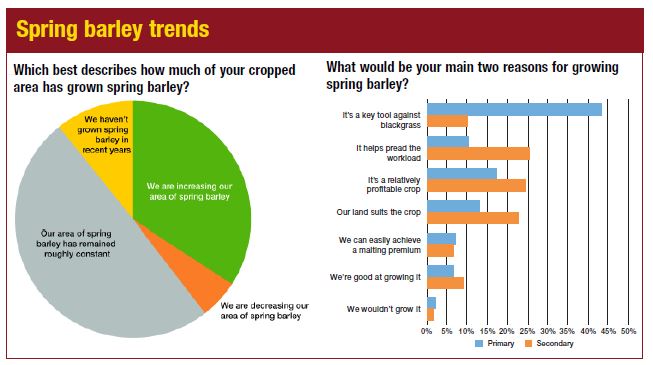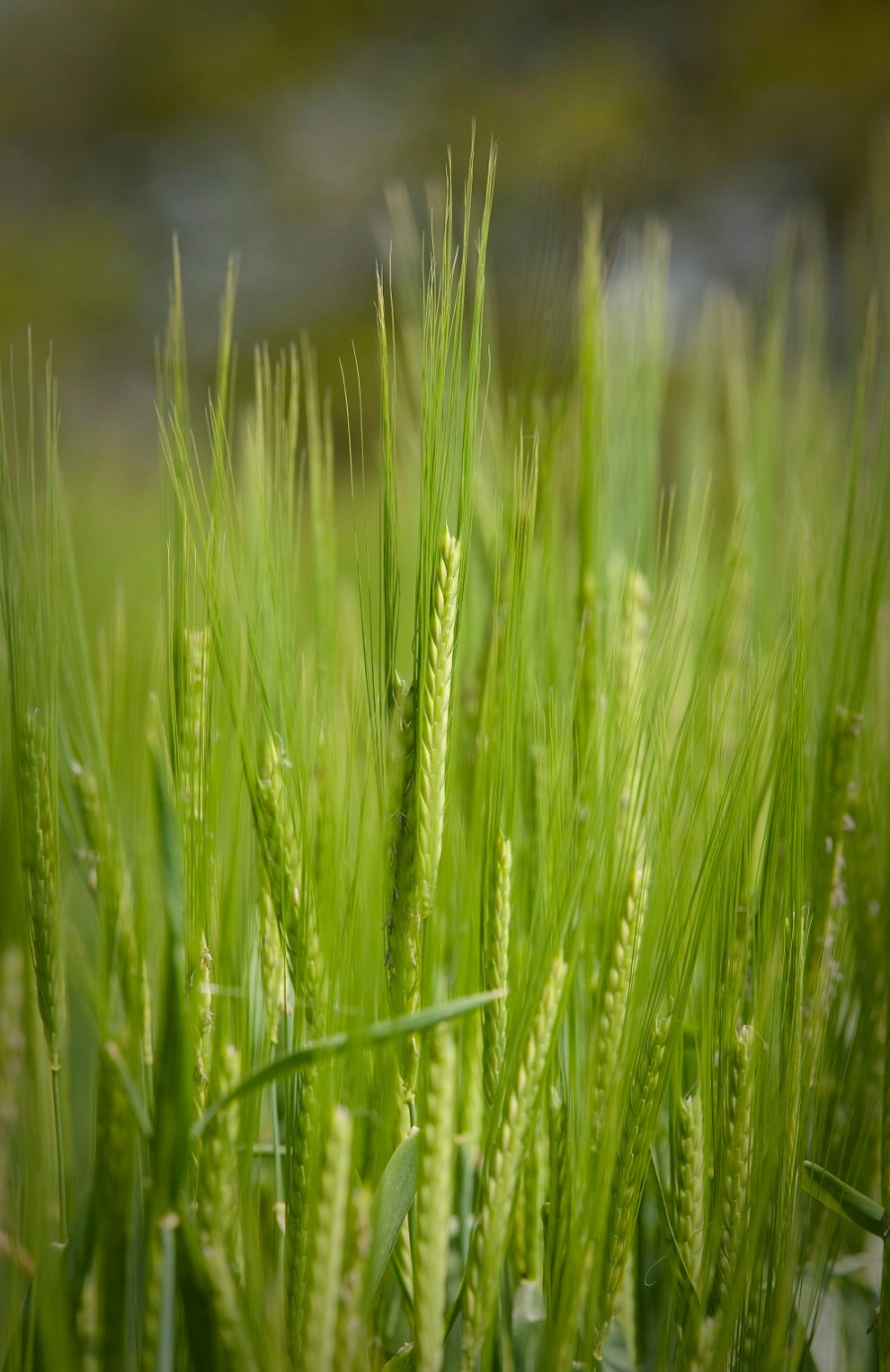Spring barley is gaining in popularity, and blackgrass is the main reason, according to a CPM/RAGT survey. But failing to meet contract spec could be putting a dent in returns.
It is important for growers to pay attention to achieving the contract spec.
By Tom Allen-Stevens
The UK could be heading towards its biggest ever spring barley crop, if the results of a recent CPM/RAGT survey ring true. Over 90% of growers who responded said they intend to include the crop in their plans for 2017. But experts have cautioned that growers should consider the market and look to secure a contract before placing their seed order.
Increased area
According to the survey, around a third of growers have increased their area of spring barley, while for half of the respondents the area cropped has remained roughly constant. Just 5% have reduced the area grown, while 11% haven’t grown the crop in recent years.
Jonathan Arnold of Robin Appel notes the figures of the survey may be skewed towards growers with an interest in spring barley, but he’s seen the crop grow in popularity in recent years.
“I’d say 70-75% of growers are including spring crops in the rotation, with the majority choosing barley. We’ve seen the crop spread from the traditional areas of East Anglia, the Yorks and Lincs Wolds, Hants and Wilts towards the rest of the arable area. It’s now commonly grown by the big-yielding wheat growers with heavy land,” he says.
The increase in area grown will be met with mixed feelings by traditional malting barley growers, reckons Stuart Shand of Gleadells. “Domestic demand is around 1.85M tonnes but in the last few years, there’s been as much as a 750,000t surplus. Unless like this year there’s a big demand for export, it keeps a lid on premiums.”

But it’s not all good news for the newcomers, either, he notes. “We’ve had a couple of years of good yields, but the downside is that rejection rates have been high, particularly for those with blackgrass where ergot has got into the sample. It is important for growers to pay attention to achieving the contract spec.”
The agronomic argument for growing spring barley is a compelling one, however, and the survey backs this up, with 43% saying the fact the crop is a key tool against blackgrass is their main reason for growing it. What’s more, of those growers, almost half reckon it’s the best crop in the rotation for that reason, while a further 43% say it’s the best spring crop against blackgrass.
Aside from this, spreading the workload, crop profitability and land suitability were cited as key secondary reasons for growing spring barley. But just 7% of growers note they can easily achieve the premium.

The trend is likely to continue, believes Stuart Shand. “We’ll see a further reduction in the winter malting area – maltsters are now struggling to find room for those varieties. Also, breeders in the main have stopped investing in the crop as hybrid varieties have taken over the winter area.”
The picture for spring barley, on the other hand, is quite different, notes Adrian Fisher of Openfield. “For growers, it’s moved from a Cinderella crop in quite low demand right up to a mainstream cereal option. The crop has developed, and a lot of that’s down to the effort of breeders – we’re seeing varieties come on the market that are pan-European, or have even global appeal, which makes them reliable and consistent.”
He says Quench was probably the first variety that had such broad uptake, and marked a step forward for the crop. “A lot of varieties had Quench in their parentage, but didn’t make the grade. Now we’re seeing breeders deliver more consistency, so varieties like RGT Planet and KWS Irina will be grown across the world – that wouldn’t have happened 20 years ago.”
Contract spec
Despite this high level of consistency from modern varieties, failure to meet the contract spec is clearly a problem, with 36% highlighting it as their main concern. More than a quarter of growers say brackling is their main concern, but only 5% highlight storage issues.
“Brackling will make or break a variety,” points out Jonathan Arnold. “But one that’s susceptible to it simply wouldn’t get on the AHDB Recommended List, these days. Disease resistance is less of a priority than it is in a winter crop – rhynchosporium is the one to watch, but modern varieties are fairly robust and we’ve a good chemical armoury still for barley disease.”

He notes that some growers in non-traditional spring barley areas are struggling to achieve the quality and consistency varieties are capable of. “But the crop has a clear attraction, aside from the blackgrass element – it takes the pressure off the autumn workload, and allows for some over-winter green manuring, such as cover crops, which are increasingly popular. A spring crop also gives you plenty of stubbles which can help with environmental schemes.
“So there’s a wide array of reasons to grow spring barley, but there are also a lot of options for marketing the crop. There are now some fantastic framework agreements and farmers who want to improve returns should align themselves better with specific malting barley contracts.”
It’s an issue that hasn’t gone unrecognised, with 58% of growers citing market outlet as the most important attribute for a spring barley variety, after yield. A variety must have full Institute of Brewing and Distilling (IBD) approval, say 54% of survey respondents, and a further 22% say it must at least be on test or have provisional approval. Around half of respondents feel export potential is important.
“Market outlet is key,” agrees Stuart Shand. “There’s no point growing a variety your local maltster or shipper won’t take. For brewing or export, currently Propino is still the one that everyone wants. After that, RGT Planet and then KWS Irina would be my choice.”
Meeting the contract spec is also key for making the most from the crop. Currently the malting premium looks attractive, at around £25-30/t, but is expected to slip to a more average £20/t for next season’s crop. The market is split between the low 1.5-1.6%N distilling crop that heads for Scotland, and the other half, going for brewing or export at around 1.85%N, with some contracts as high as 2%N.
“Firstly, it must be stored well,” advises Stuart Shand. “It’s a living product and can’t all be shifted close to harvest. Secondly, if you’re a new grower be careful what you promise contractually – you may benefit from a contract with flexibility or low risk, such as pool marketing, and it’s well worth discussing your options with a malting barley specialist before putting in your seed order – you may be growing the crop for agronomic reasons, but don’t let your agronomist choose the variety.”
Pass rate
Nationally the pass rate for meeting contract spec varies year on year, but averages around 75%, reckons Adrian Fisher. “Dyed-in-the-wool spring barley growers rarely fail to meet the required standard – they’ll stick with the variety they know and will probably achieve a consistent result. It’s the nouveau growers who are more prone to failure and may want to consider the balance between yield and achieving the premium.”
They should look firstly for IBD approval, he says. “This is also an indicator of export potential, which may not be a concern in East Anglia where there are local maltsters. But for Wilts, Hants and Lincs growers, especially, export potential is extremely important.”
RGT Planet and Octavia have now joined the list with full approval, that includes Propino, KWS Irina, Concerto and Odyssey. “But it’s not just about approval. The maltster wants consistency of supply, so Propino or Concerto are the mainstream varieties in the UK today. But these are now significantly lower yielding than RGT Planet, which will be forced in for agronomic reasons.”
Much comes down to the individual grower, he says. “If a malting sample is your thing, you’ll probably stick with Propino for brewing or Concerto for distilling. If you’re not sure you’ll meet the contract spec, it may be worth growing for out-and-out yield, in which case Planet or Irina would be a better choice.”
A professional approach ensures success from spring barley
Blackgrass, and a determination to beat the grassweed, lay behind Andrew Crossley’s decision to grow spring barley on the Thurlow Estate, based in Suffolk.
“We’re trying a number of techniques to combat blackgrass. Spring crops are not best suited to our predominantly heavy soils, and it was almost by accident that we ended up with an area we drilled to spring barley. But the farm’s grown the crop in the past, so I was confident we should achieve the grade,” he says.
With 5100ha farmed across Suffolk, Essex and Cambs, that puts immense pressure on the autumn cultivation window. “We’ve been pushing drilling dates back on fields with bad blackgrass. But there were 180ha we didn’t manage to get drilled last autumn as conditions deteriorated.”
Barley looked to be the best spring option, but new to the crop, Andrew Crossley was aware there were risks involved. “My main concern was whether spring barley would yield, especially if conditions turned dry. There was also the question of a market for the crop.”
After consulting with Openfield, he decided to opt for RGT Planet with a view to supplying local maltsters through one of the Openfield’s pools. “This seemed a relatively low risk option. At the time, Planet didn’t have full IBD approval, but the variety looked as though it had the right characteristics with yield potential,” he says.
“We didn’t manage to drill until relatively late in the spring. But in the end the crop gave us a decent return – 6.72t/ha and it should go for malting. What’s more, there was no blackgrass seed return, despite being grown in fields with a history for the weed.”
With a grain N of 1.62%, the crop’s now in store, due to be moved in Nov and Feb, with a contract spec for malting of 1.75%N. “Getting the right grain N is down to nitrogen rate and timings – you just have to know what you’re doing. We’ve an on-floor, ventilated store and were careful to bring the crop in dry and are keeping it cool and well ventilated, so it’s effectively inert,” he notes.
Spring barley is now in the cropping plan for 2017, says Andrew Crossley. “We’re going to go with RGT Planet again, but this time aim to drill earlier, having already created a partial seedbed in the autumn.”
Flying high after survey entry
Congratulations to Beds grower Allan McNicoll, who’ll be receiving 5t of RGT Planet spring barley seed, worth £2000, for taking part in the CPM/RAGT spring barley survey.
He completed the survey and gave the answer judged best to its tie-breaker question: “the key to success with growing spring barley is to outcompete blackgrass, have a fairly broad sowing window, meet specifications and be profitable”.
Three other lucky respondents each received a case of delicious RGT Planet ale – full details can be found a. All four prize-winners responded to an email inviting them to take part in the online survey. To take part in the next survey, make sure we have the correct details for you by emailing info@cpm-magazine.co.uk




